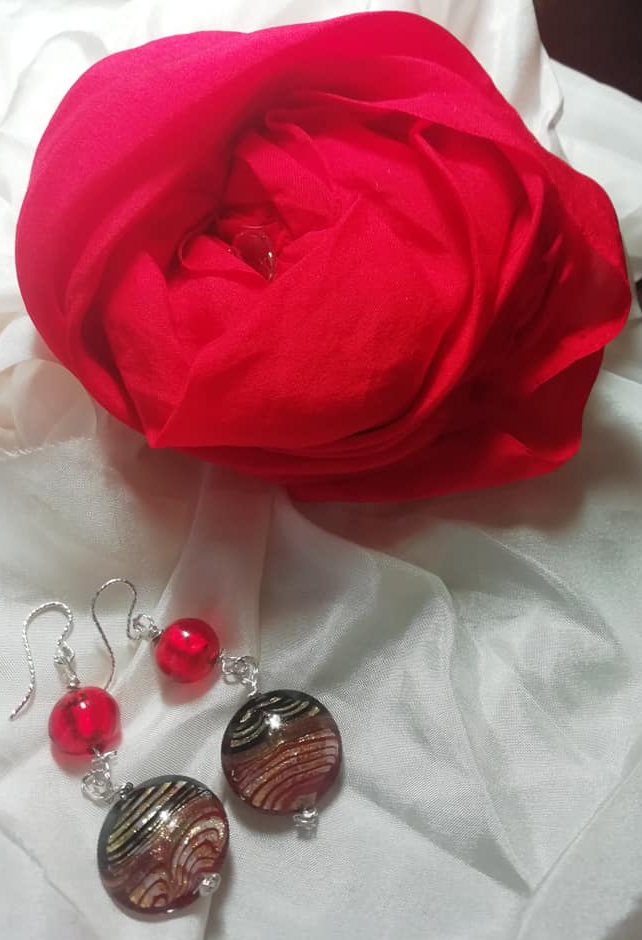The History of Silk

Rose made with Habotai Silk
The legend of silk discovery .... it is said that around 3000 BC the Empress Xi Ling Shi (also known as Xilingshi, Lei-Tsu or Leizu), wife of the Yellow Emperor, Emperor Huangdi, was sitting under a mulberry bush drinking tea when a silkworm cocoon fell into her cup and started unravelling, the Empress realised the result was a single thread and intrigued she wondered if the thread could be used for cloth.
The empress is then said to have studied and with help from a scientist, bred the silk moth and silk worm and developed not only sericulture but the loom to work the cloth on.
Silk was the preserve of the elite and the colour worn was a clue to class.
Although the Chinese managed to keep the secret for many centuries, it was inevitable that the teachings of silk production would gradually spread: Chinese migrants, international marriages and subterfuge all played their part. When the Byzantium Empire learned sericulture, in around AD 550, the church and state kept control of their own industry establishing silk production in the Middle East, India had learned around AD 300, each culture was determined to keep sericulture a closely guarded and profitable secret.
At the time of the Second Crusades 2000 silk weavers from Constantinople were established in Italy and silk production reached several areas in Europe. Italy began to produce high quality silks and were able to become a major player on the silk producing stage, there are still high quality silks produced in Italy to this day.
James I of England (1566 - 1625, aka James VI of Scotland) tried, unsuccessfully to start sericulture in England, but although his failure (due to the English climate and the fact he imported black mulberry bushes instead of white mulberry bushes for the silkworm to feed on) meant the silk had to be imported, but the skills of the silk worker were abundant in the UK with migrants from other areas of Europe.
More of Silk in England
The earliest known references to silk in the East Cheshire area are in the inventory of button maker Stephen Rowe dated 1617, silk first arrived in England in the 1100s, along the trade routes that also brought jade and spices from the Orient.
Silk working sprang up in several areas of England. London, Norwich, Derby, Congleton and Macclesfield were the mainstays of the industry in Britain.
With the coming of the Industrial Revolution silk button making ceased to be a cottage industry and mills were erected for the mechanisation of the business - now fabrics could also be produced and the industry flourished.
The first British silk mill was built in Derby by Thomas Lombe, originally a weaver's son from Norwich who served his apprenticeship in London, the mill was built to house a silk weaving machine that he had patented in 1718, although sources state that Lombe's spinning machine was a copy of a machine used by the Italians since the early 1600s.
Other mills were inspired and built in Manchester, Chesterfield, Macclesfield, London, Stockport and Norwich, copying Lombe's design. Charles Roe built Macclesfield's first Silk Mill in 1744.
Macclesfield was synonymous with silk. The town's fortunes rose and fell with the silk industry. This appears to be a town built on silk, yet it is not Macclesfield which is remembered for silk buttons, although these were a large part of the silk production line with examples displayed in the local museum.
Button making played a large part in the silk industry of Macclesfield, pre-dating the textiles that followed, but it is a Staffordshire town which is remembered throughout the world for the range of wooden based silk buttons it is plausible that the inhabitants learned their craft from Macclesfield or Manchester; although several records quote the arrival of French refugees in 1685 as the area's introduction to silks. (French Huguenots arrived in Spitalfields, London at this time), designs of this type are known as "Leek buttons".
The industrial centres of Macclesfield and Manchester enticed the workers away from the surrounding countryside and made the area a leader in the British Silk Industry for 200 years. The last silk mill of Macclesfield closed in 1981, Paradise Mill is now open to the public as a living museum.
| Latest Trends | Ordering Information | debbie@silkpixie.com | Delivery & Returns |


